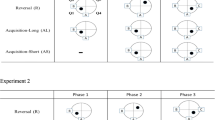Abstract
Rats were trained in a Y-maze on a two-choice simultaneous black-white discrimination with either black or white as S+. Animals were then transferred to one of three discrimination tasks. In task 1 (New S−), a new stimulus, either vertical or horizontal stripes, was substituted for the original S−. In task 2 (New S+), a new stimulus, either vertical or horizontal stripes as in task 1, was substituted for the original S+. In task 3 (New S+/S−) animals were trained on horizontal-vertical discrimination. The pre-trial administration of 1 mg/kg d-amphetamine facilitated the acquisition of the original black-white discrimination with both black as S+ and white as S+. Likewise, the drug improved performance in all three transfer conditions. However, the course of learning in the three transfer tasks was different in the placebo- and amphetamine-treated animals. Amphetamine-treated animals were disrupted more by a change in S+ than by a change in S−, whereas the opposite pattern was evident in the placebo controls. When both discriminative stimuli were changed, placebo animals exhibited pronounced decrement in performance, whereas amphetamine animals exhibited excellent learning. The implications of these findings for the effects of amphetamine on discrimination learning are discussed.
Similar content being viewed by others
References
Ahlenius S, Carlsson A, Engel J (1975) Antagonism by baclophen of the d-amphetamine-induced disruption of successive discrimination in the rat. J Neural Transm 36:327–333
Altman JL, Appel JB, McGowan WT III (1979) Drugs and the discrimination of duration. Psychopharmacology 60:183–188
Bitterman ME, McConnel JV (1954) The role of set in successive discrimination. Am J Psychol 67:129–132
Calhoun WH, Jones EA (1974) Methamphetamine's effect on repeated acquisition with serial discrimination reversals. Psychopharmacologia 39:303–308
Eck KO, Noel RC, Thomas DR (1969) Discrimination learning as a function of prior discrimination and nondifferential training. J Exp Psychol 82:156–162
Evenden JL, Robbins TW (1985) The effects of d-amphetamine, chlordiazepoxide and alpha-flupenthixol on food reinforced tracking of a visual stimulus by rats. Psychopharmacology 85:361–366
Geller I, Hartmann RJ, Moran E (1983) Phenobarbital and d-amphetamine effects on discrimination performance of rats and juvenile baboons. Pharmacol Biochem Behav 18:107–113
Grilly DM, Genovese RM, Novak MJ (1980) Effects of morphine, d-amphetamine and pentobarbitol on shock and light discrimination performance in rats. Psychopharmacology 70:213–217
Hall G (1974) Transfer effects produced by overtraining in the rat. J Comp Physiol Psychol 87:938–944
Heise GA, Lilie NL (1970) Effects of scopolamine, atropine and d-amphetamine on internal and external control of responding on non-reinforced trials. Psychopharmacologia 18:38–49
Koek W, Slangen JL (1983) Effects of d-amphetamine and morphine on discrimination: signal detection analysis and assessment of response repetition in the performance deficits. Psychopharmacology 80:125–128
Ksir C (1975) Scopolamine and amphetamine effects on discrimination: interaction with stimulus control. Psychopharmacologia 43:37–41
Ksir C, Slifer B (1982) Drug effects on discrimination performance at two levels of stimulus control. Psychopharmacology 76:286–290
Kulig BM, Calhoun WH (1972) Enhancement of successive discrimination reversal learning by methamphetamine. Psychopharmacologia 27:233–240
Lyon M, Robbins TW (1975) The action of central nervous system stimulant drugs: a general theory concerning amphetamine effects. In: Essman WB, Valzelli L (eds) Current developments in psychopharmacology, vol 2, Spectrum, New York, pp 79–163
Mackintosh NJ (1974) The psychology of animal learning. Academic, London
Mackintosh NJ (1983) Conditioning and associative learning. Oxford University Press, New York
Mandler JM (1966) Behavior changes during overtraining and their effect on reversal and transfer. Psychonom Monogr [Suppl] 1:187–202
Mandler JM (1968) Overtraining and the use of positive and negative stimuli in reversal and transfer. J Comp Physiol Psychol 66:110–115
Moerschbaecher JM, Thompson DM (1980) Effects of phencyclidine, pentobarbital and d-amphetamine on the acquisition and performance of conditional discriminations in monkeys. Pharmacol Biochem Behav 13:887–894
Mullins GP, Winfield AH (1979) The relative importance of responses to S+ and S− in simultaneous discrimination learning. Q J Exp Psychol 31:329–338
Nielsen EB (1981) Effects of d-amphetamine and LSD on simultaneous discrimination. In: Bradshaw CM, Sabadi E, Lowe CF (eds) Quantification of steady-state operant behavior. Elsevier, Amsterdam, pp 461–464
Nielsen EB, Appel JB (1983) The effects of drugs on the discrimination of color following a variable delay period: A signal detection analysis. Psychopharmacology 80:24–28
Restle F (1958) Toward a quantitative description of learning set data. Psychol Rev 65:77–91
Ridley RM, Baker HF, Haystead TAJ (1981a) Perseverative behavior after amphetamine: Dissociation of response tendency from reward association. Psychopharmacology 75:283–286
Ridley RM, Haystead TAJ, Baker HF (1981b) An analysis of visual object reversal learning in the marmoset after amphetamine and haloperidol. Pharmacol Biochem Behav 14:345–351
Robinson TE, Becker JB (1986) Enduring changes in brain and behavior produced by chronic amphetamine administration: a review and evaluation of animal models of amphetamine psychosis. Brain Res Rev 11:157–198
Rodgers JP, Thomas DR (1982) Task specificity in nonspecific transfer and extradimensional stimulus generalization in pigeons. J Exp Psychol [Anim Behav] 8:301–312
Siegel S (1967) Overtraining and transfer processes. J Comp Physiol Psychol 64:471–477
Stevens DA, Wixon DR (1975) Assessment of relative importance of S+ and S− after various stages of training. Bull Psychonom Soc 5:462–464
Sutherland NS, Mackintosh NJ (1971) Mechanisms of animal discrimination learning, Academic, New York
Thomas DR (1969) The use of operant conditioning techniques to investigate perceptual processes in animals. In: Gilbert RM, Sutherland NS (eds) Animal discrimination learning. Academic, London
Thomas DR, Freeman F, Svinicki JG, Burr DES, Lyons J (1970) Effects of extradimensional training on stimulus generalization. J Exp Psychol Monogr 83:1, Part 2
Weiner I, Feldon J (1986) Reversal and nonreversal shifts under amphetamine. Psychopharmacology 89:355–359
Weiner I, Ben-Horin E, Feldon J (1986a) Amphetamine and the overtraining reversal effect. Pharmacol Biochem Behav (in press)
Weiner I, Feldon J, Ben-Shahar O (1986b) Simultaneous brightness discrimination and reversal: The effect of amphetamine administration in the two stages. Pharmacol Biochem Behav (in press)
Author information
Authors and Affiliations
Rights and permissions
About this article
Cite this article
Weiner, I., Feldon, J. & Ben-Horin, E. Facilitation of discrimination transfers under amphetamine: the relative control by S+ and S− and general transfer effects. Psychopharmacology 93, 261–267 (1987). https://doi.org/10.1007/BF00179945
Received:
Revised:
Issue Date:
DOI: https://doi.org/10.1007/BF00179945




